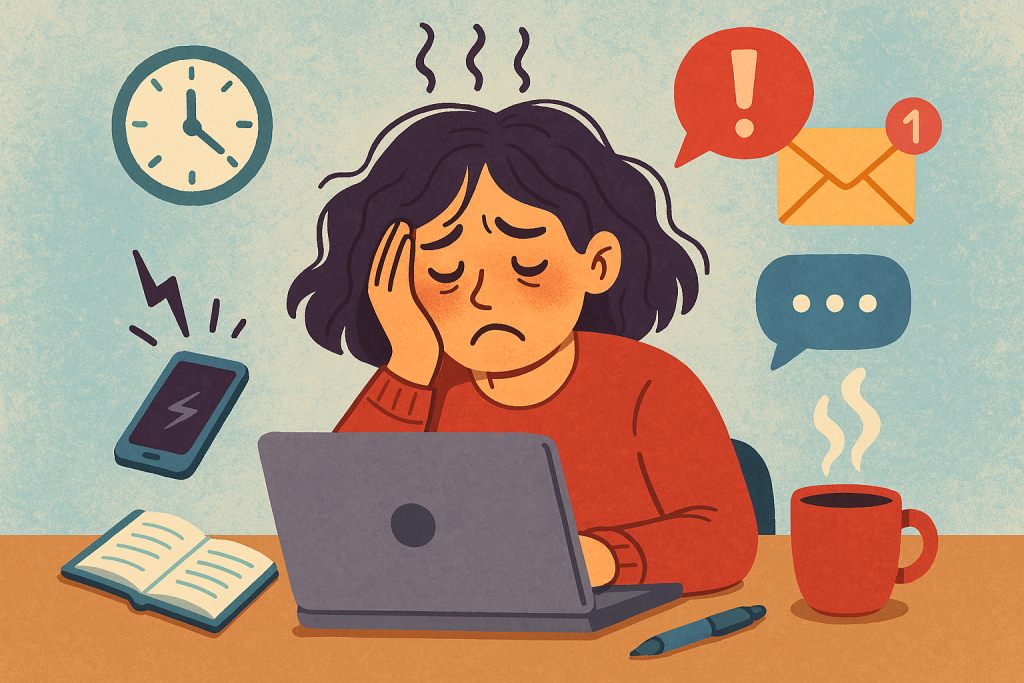We often hear “stress” used broadly—but digital burnout feels different from regular stress, seeping into your brain and daily habits. This article explores why, backed by emerging research and practical solutions.

1. Defining the Difference: Burnout vs Digital Burnout
Occupational burnout (regular stress) is a recognized work-related condition featuring emotional exhaustion, cynicism, and reduced performance. It often develops from chronic workplace pressure and poor balance.
By contrast, digital burnout stems specifically from excessive screen and tech use—governed by constant notifications, multitasking, and no clear off switch. So, digital burnout feels different from regular stress due to its unique origins and symptoms.
2. The Neuroscience of Constant Connectivity
Modern neuroscience reveals why digital demands take a heavier toll:
- Researchers describe tech triggers—beeps, pings—as physiological stressors, activating cortisol/adrenaline responses in the brain.
- These dopamine-driven feedback loops are fleeting rewards that fatigue the brain over time.
- Constant notifications force continuous partial attention, which depletes working memory, weakens cognitive flexibility, and heightens anxiety.
Bottom line: unlike typical stress, digital burnout hijacks your neural circuits—dampening focus and rewiring your stress responses.
3. Key Symptoms That Stand Apart
Cognitive Fog Beyond Tiredness
Digital burnout leads to confusion, difficulty focusing, and memory lapses—not just exhaustion.
Physical Stress in Tech Context
Typical burnout includes tiredness; digital burnout adds screen-specific aches—headaches, eye strain, neck stiffness .
Digital Presenteeism
Remote work and always-on culture drive digital presenteeism—employees feel pressured to stay online, even during off-hours.
Emotional Numbness vs Cynicism
While burnout often yields cynicism toward work, digital burnout creates emotional disconnection from both tasks and tech itself.
4. Why the Trend Is Gaining Momentum
24/7 Access and Hybrid Work
Remote and hybrid work cultures blur lines between personal and professional life. One study found 78% of remote workers average 9 hours of screen time—leading to fatigue, insomnia, and irritability .
Role of AI-Driven Feedback Loops
Apps deliver non-stop notifications and metrics—these feedback loops boost anxiety and weariness, and erode autonomy.
Gen Z Shows Red Flags
About 20–30% of adults report digital burnout; for Gen Z, it’s even worse—up to 40% among urban students.
5. Real-Life Effects of Digital Burnout
- Performance: multitasking and digital stress degrade creativity and attention.
- Health: increased cortisol, disrupted sleep, migraines, and eye strain .
- Relationships: digital fatigue diminishes empathy in real-world interactions.
- Mental health: heightened anxiety and depression—especially among teens and caregivers .
6. How to Combat Digital Burnout
6.1 Set Smart Digital Boundaries
- Define tech-free periods (e.g., after 8 pm).
- Turn off notifications during work blocks.
- Implement “buffer zones” before bed or meetings.
6.2 Practice Mindful Tech Use
- Use apps that track screen time.
- Identify high-stress triggers and re-evaluate usage.
- Limit news/social media if it induces anxiety.
6.3 Schedule Regular Digital Detoxes
- Short breaks or full days unplugged refresh neural circuits .
- Consider weekend retreats or flexible workdays offline.
6.4 Optimize Digital Workflows
- Batch notifications and emails instead of checking constantly.
- Use do-not-disturb modes during intensive tasks.
6.5 Invest in Self-Care
- Prioritize sleep, exercise, healthy diet.
- Incorporate mindfulness, walking, or relaxation practices.
- Build digital-free social time into your weekly routine.
7. When to Seek Help
If your screen fatigue leads to chronic emotional exhaustion, depression, or physical symptoms, consult a mental health professional. Organizational support—such as tech-free meetings or flexible policies—can be pivotal.
8. Key Takeaways
- digital burnout feels different from regular stress because it involves unique neural, cognitive, and digital-presence patterns.
- It causes cognitive fog, physical discomfort tied to devices, and emotional numbness related to tech, not just work.
- Modern factors—remote work, social media feedback loops, and pressure to stay online—are amplifying it.
- Effective management requires intentional digital boundaries, mindful tech habits, regular detoxes, and self-care routines.
Final Thoughts
Digital burnout may be subtle initially, but its effects compound—leaving you wired, fatigued, and disconnected. Recognizing how it diverges from regular stress is essential. By shifting your relationship with tech—from reaction to intention—you can reclaim mental clarity and emotional balance.
References
Battal Göldağ (2022). An Investigation of the Relationship between University Students’ Digital Burnout Levels and Perceived Stress Levels. Journal of Learning and Teaching in Digital Age, 7(1), 90–98. Retrieved from https://dergipark.org (2022)
Mohammad Belal, Nguyen Luong, Talayeh Aledavood & Juhi Kulshrestha (2025). Stress Bytes: Decoding the Associations between Internet Use and Perceived Stress. arXiv, May 21, 2025. Retrieved from https://arxiv.org/ (2025)
Technostress (2025). Technostress. Wikipedia. Retrieved from https://en.wikipedia.org (last updated 2025)






